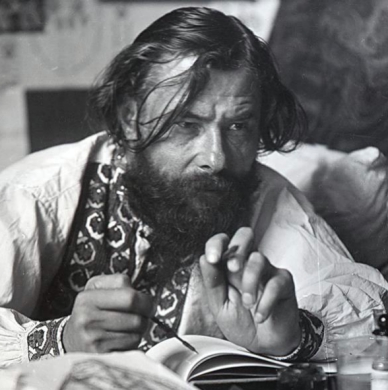At the exposition of the show “Oleksa Nowakiwsky. Graphics (in the frames of the project “Grand Masters”)” there are sketches and graphics composition of Oleksa Nowakiwsky – famous Ukrainian artist (1872-1935). The harmonious and virtuosic feather, pencil and charcoal drawings show the variation of the ideas, which were interested in the artist during the whole his life.
An important place in his creative contribution takes the self-portraits and allegorical compositions with his own image. Time to time the artist worked with this genre during the whole life and created in this genre more than half a score of the oil self-portraits and more than hundred feather, pencil and charcoal sketches. At the exhibition is presented the sketch of the first artwork “Self-portrait” (1998). This skillfully and realistically sketch was created by Nowakiwsky when he was a student at the School of Fine Arts in Krakow. The next self-portraits of the artist we can notice the influence of the esthetic of the symbolism – the artist works with different signs-symbols. The self-portraits present not only the steps of his life and the transformation of his ideas and outlook but show the actual problems of that period in history as well.
Sometimes in his allegorical compositions, Nowakiwsky combines his own image and the image of his wife – Anna-Maria Palmowska, who, on the one hand, creates the antithesis, and on the other hand – harmonically complements the self-portrait of the artist. At the exposition there are sketches: “Self-portrait with the Muse”, 1916; “Deepness”, 1917, which have as a self-biographical plot, so as a deep allegorical and symbolical background. Anna-Maria was not only a favorite model and muse of the artist but a mother of his children, s true friend and soulmate. At the exposition, there are sketches to the portraits of Anna-Maria (“Sketch to the Bust Portrait”, 1920th; “Near the Apple Tree. Anna-Maria with her Son Jaroslaw”, 1921; “To the Party”, 1923).
When the artist had moved to Lviv, he started to create pretty strong with deep ideological and semantic content, pretty symbolical and metaphorical compositions. For instance, allegorical panel for the Musical institute named after M. Lysenko (at the exhibition – sketch to the medallion “The Science”).
Some important place in the Nowakiwsky’s creative contribution takes the character of the Metropolitan Archbishop Andrey Sheptytsky (1865-1944), who was not only a leader of Ukrainian Greek-Catholic Church but a philanthropist of the Ukrainian culture. Sheptytsky supported in different ways the artist, so that Nowakiwsky presented to Archbishop a lot of his artworks: the paintings, more than 200 sketches to the portrait (“During the Work”, 1914; “In the Miter”, 1915; “On the Drapery Phone”, 1915; “During the Conversation”, 1916) and a lot of sketches for the different multi-files compositions (“The Hard Nap”, 1920). In these portraits and allegorical artworks, Nowakiwsky skillfully tried to show not only the character of the Archbishop but some elements of the Ukrainian social-culture, historical and spiritual space and outlook.
The time from 1914 had a strong influence on Nowakiwsky, so that he started to create the heroically-historical topics. For example, he drew the portraits of the Kyiv and Galician princes and others heroically characters, and at the same time, mythologized and transformed them. The penetrating composition-allegory “The Angel of Death”, which had a lot of interpretations, shows the pain and despair, which had appeared after the events of the liberation struggle. Nowakiwsky showed two imagines, which were combined into one whole with a clear contour line: monumental wing messenger of death holds in his hands the body of the dead sich riflemen, and the background of this action is very symbolical.
One more important part of his art goes to sacred art, which is symbolical too. For creation, the allegorical canvas Nowakiwsky used not only the main principles of the iconography but some Christian symbols as well. For instance, in different variants of the artworks from the circle “Renaissance”, which symbolizes the national renaissance of Ukraine, the artist showed the women imagine (model – Anna-Maria Palmowska) on the background with icons of Mother of God, Jesus Christ, iconostasis, and Crucifix. Working with an image of Jesus Christ and Virgin Mary, Nowakiwsky looked at ideas and aesthetics of the monumental plastic of the Italian Renaissance, old Ukrainian iconography, and Ukrainian Baroque.
Probably the main artwork in all his creative contribution is his last artwork – the icon “Mother of Mercy” (“St. George’s church Madonna”). Nowakiwsky created it for the central part of the iconostasis in the church of St. George in Lviv but didn’t complete. This image is in some case the conclusion of his previous artwork with the topics about Mother of God, and his formal-plastic searches and figurative solutions. Creating this future icon, Nowakiwsky drew around twenty oil sketches and almost hundred feathers, pencil and charcoal sketches.
Iryna Rizun
